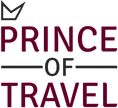
Rewriting the travel experience.
Prince of Travel is a team of expert travellers dedicated to educating, informing, and inspiring our readers on maximizing the power of Miles & Points to travel the world at a fraction of the price.
News. Deals. Guides. Reviews. Start here. Read anywhere.
Explore our curated platform of over 2,000 articles, updated every day, designed to elevate your travel experiences and ignite your wanderlust. Dive into a wealth of meticulously crafted content, ranging from breaking travel news to insider deals, comprehensive travel guides, and in-depth reviews of the world’s best travel experiences.
Credit Cards. Everything you need to travel better.
Whether you’re earning points on daily expenses or enjoying priority boarding and complimentary hotel stays, the right credit card can supercharge your adventures around the world. Explore our database of 100+ credit cards to select the perfect credit card tailored to your exact needs.
Top Offers
Travelling on Points? We've got your back.
For the vast majority of people, “rewards” or “points” are an afterthought at best. Most people don't realize that leveraging travel rewards to their full potential can truly transform the way you travel. Check out our Newbie's Guide to equip you with all the basic knowledge you need for earning points and travelling the world.
Join our community. Get the best travel news, guides, deals and more.
Join the Prince of Travel community and discover a world of exclusive travel insights. Unlock a wealth of curated travel news, expert guides, irresistible deals, and much more. Subscribers receive a weekly newsletter every Sunday filled with tips, tricks, and strategies to enrich your travel experiences and inspire your wanderlust.
Who we are. We make travel better, easier & more accessible.
At our core, Prince of Travel is dedicated to enhancing the experience of travel, making it more seamless, accessible, and enjoyable for all. We strive to unlock the mysteries of credit cards, loyalty programs, and points, empowering the average person to explore the world with ease. From hotel and airline reviews to breaking travel news and how-to guides, we are your trusted partner in unlocking the power of Miles & Points to its fullest potential and making your dream trips a reality.












